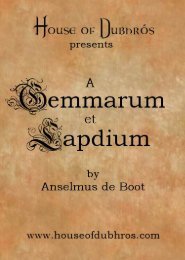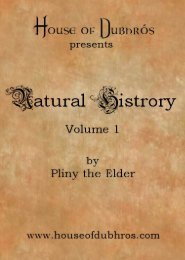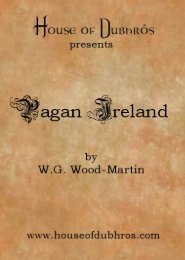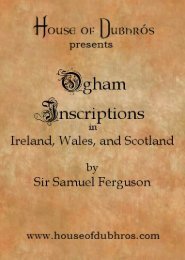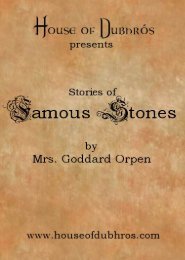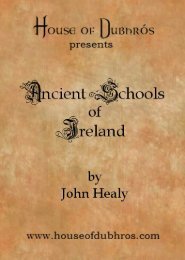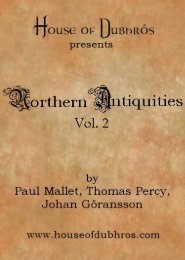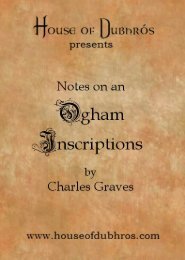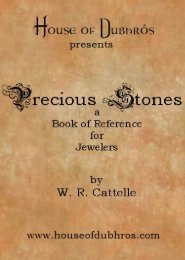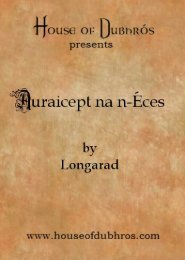You also want an ePaper? Increase the reach of your titles
YUMPU automatically turns print PDFs into web optimized ePapers that Google loves.
16 The Anglo-Saxon Runic Poem<br />
32 Ger by]? gumena hiht, Sonwe God laete)?,<br />
halig he<strong>of</strong>ones cyning, hrusan syllan<br />
beorhte bleda beornum ond Searfum.<br />
35 Eoh by)? utan unsme]?e treow,<br />
heard hrusan fsest, hyrde fyres,<br />
wyrtrumun underwre)?yd, wyn on e)?le.<br />
38 PeortS<br />
by]? symble ple a and hlehter<br />
wlancum [on middum], Sar wigan sitta)?<br />
on beorsele<br />
bli)?e aetsomne.<br />
41 Eolh-sec^r eard hsef]? <strong>of</strong>tust on fenne<br />
wexeS on wature, wunda]? grimme,<br />
/ blode breneS beorna gehwylcne<br />
8e him senigne onfeng gede]?.<br />
45 "f&gel semannum symble bi]? on hihte,<br />
Sonne hi hine feria]?<br />
<strong>of</strong>er fisces<br />
be]?,<br />
o}> hi **,<br />
brimhengest bringe]? -<br />
to lande.<br />
32. H. ffon. 37. H. wynan on eple. 39. on middum supplied<br />
by Grein. 41. H. eolhx seccard.<br />
32. Ger (Salz. OE. gaer, Goth, gaar) = summer.<br />
Gear originally meant the warm part <strong>of</strong> the year (cf. Russian apB,<br />
"spring-corn"), parallel to winter; this meaning is occasionally found in<br />
AS., e.g. Beowulf, v. 1134. Then both gear and winter were used for<br />
the whole year, though at a later time winter was restricted to its original<br />
significance.<br />
In Scandinavian dr came to denote the "products <strong>of</strong> the summer," hence<br />
"plenty, abundance," e.g. til drs okfriffar, "for peace and plenty."<br />
In the older alphabet the letter stood for J ; but the initial j, falling<br />
together with palatal g in AS., is almost invariably represented by the gyfu<br />
letter in inscriptions. Cf., however, v. 87, iar.<br />
35. Eoh :<br />
except in Runic alphabets this word is written iw, se hearda<br />
iw <strong>of</strong> Riddle LVI. 9; but cf. OHG. iha beside iwa. The original form may<br />
have been *ihwiz. Hickes gives the value as eo, doubtless taken from<br />
Domit. A. ix. The value <strong>of</strong> the letter in the original alphabet is quite<br />
unknown ; but the Salzburg Codex has ih with the values i and h, and this<br />
agrees with the only intelligible inscriptions in England in which the letter<br />
occurs, viz. Dover: Gislheard (value i) ; Ruthwell : Almehttig (value h);<br />
Thornhill II : Eateinne for Eadpegne (value i).<br />
Eoh survived as yogh, yok, etc., the name <strong>of</strong> the 3 letter in Middle<br />
English. Cf. A. C. Paues, M. L. R. vi. 441 ff.<br />
38. PeorS (Salzb. AS. peord, Goth, pertra). P was a rare sound in<br />
the parent language. It is absent from the earliest Northern Inscriptions,<br />
and in the alphabet from the Vadstena bracteate is represented by B. The<br />
brooch from Charnay, Burgundy, has in this place a letter much resembling<br />
the modern W, and in England it is found only in MS. lists <strong>of</strong> runic<br />
characters and on coins (e.g. Pada, Epa), never in inscriptions.<br />
Peorff is never found save as the name <strong>of</strong> the letter P, and no stress can<br />
be laid on any <strong>of</strong> the suggested meanings. Leo, 'As. Glossar. Halle, 1877,



